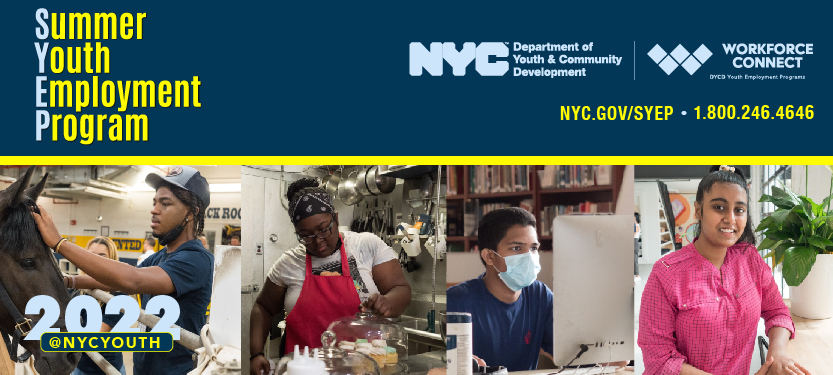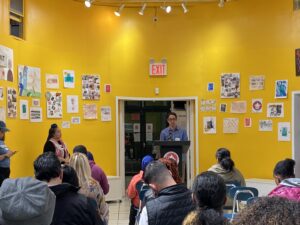For teenagers, planning summer break can be exciting, but also anxiety inducing for those looking to secure a job for the summer months. In NYC, teenagers who spend their summers earning extra cash for themselves or to support their families often rely on the Summer Youth Employment Program (SYEP) for job placement. SYEP is the nation’s largest youth employment program, offering NYC youth ages 14 to 24 with seasonal employment for up to six weeks as well as career readiness opportunities.

A Pathway to Success
SYEP is one of the city’s strategies to promote continued academic achievement and provide youth a pathway for career development and economic success. SYEP provides structured activity for families who may not have the means to pay for childcare, send their child to summer camp, go on vacation, or take part in an unpaid internship. Advocates for the program contend that structured programming is essential to prevent summer learning loss, the loss of academic skills and knowledge over the summer. Proponents of SYEP argue that youth considered at “educational risk” showed increased attendance and higher rates of taking and passing Regents exams after SYEP participation.
Supporters also see SYEP as a means of reducing employment disparities amongst young people of color. Individuals ages 18 to 24 experience some of the highest unemployment rates by age. Moreover, New York natives experience lower rates of college attainment, employment, and earnings than those born in other states. These disparities are even greater for people of color. Staunch advocates of the program such as Here to Here contend that SYEP’s focus on educational attainment and career development is integral to, “Young people launching successfully into family-sustaining careers.” Businesses across New York City also see SYEP as an opportunity to promote equitable access to industries, such as tech, which are underrepresented by people of color.
While the Adams administration has touted the academic and economic benefit of SYEP, it has also championed the program as a means to curb gun violence. Research shows that violence and crime increase in the summer. The Mayor’s Office has made investment in SYEP an integral piece of the Blueprint to End Gun Violence, a set of policy proposals designed to reduce gun violence in NYC, in hopes of providing more economic opportunity to young people to thwart violence and crime.
A Question of Funding
Despite the value SYEP provides to the City and the youth it serves every summer, funding commitments have fluctuated on a yearly basis. Some of the inconsistency in funding can be attributed to the change in SYEP’s funding sources. In the early 2000s, SYEP relied on the federal government for over 80 percent of its funding. However, by 2019 over 80 percent of funding came from the New York City budget alone. With a greater financial burden placed on New York City to fund SYEP, the fate of the program and its scope is more dependent on the yearly city budget process.
Unlike other public entities, New York City’s budget process entails a back and forth between the Mayor and City Council over the course of a year resulting in four different budgets. Between the Mayor’s Office’s release of the preliminary budget in January and release of the adopted budget by the end of the calendar year, funding estimates can vary dramatically. Decisions on cuts, funding, and expanding programs are dependent on both political climate and advocacy. For seasonal programs like SYEP, this means that yearly funding and the number of slots available are up in the air.
Due to its funding, SYEP has never had the capacity to grant a slot to every eligible applicant. SYEP has typically had enough funding for 70,000 slots and an additional 5,000 slots following the release of the adopted budget in June. However, over double the amount of youth apply for slots on a yearly basis. The yearly underprovision of SYEP slots has persisted despite funding for SYEP increasing on a nearly yearly basis for the past 20 years. In some years, increased funding has resulted in slot expansion but in others, it has been allocated to to cover other increasing costs such as requirements in increases to the minimum wage. The lack of a guarantee in funding for slots for any young person who wants to participate is problematic for families that rely on SYEP for structured programming for their children in the summer, especially if they have no other options and don’t have access to consistent childcare.
Uncertainty about the program’s future was exacerbated in April of 2020 when Mayor De Blasio cut the program altogether in his executive budget citing the closure of schools due to the pandemic as his reasoning. Following public outcry and advocacy by youth service workers, Mayor De Blasio re-instated a virtual version of the program with 35,000 available slots. With hours to go to the budget deadline and weeks to go before the expected start date, the Mayor’s Office reversed course on their initial decision to cut SYEP and left providers scrambling to put together plans for virtual programming.
In an effort to eliminate future uncertainty, The Adams administration announced in the release of its preliminary budget the largest investment in SYEP to date. This summer, there will be a total of 100,000 slots for summer employment, 90,000 of which will be in SYEP. Although this number still does not match the average number of yearly applications, the Adams Administration claims the program will be universal due to the expected level of application attrition. The expansion will be made possible by a $79 million increase in spending in 2023 on youth employment initiatives that will guarantee baseline funding of $236 million through 2026 for SYEP and other summer workforce programs. The funding increase will be allocated to current SYEP providers. Though the new funding is cause for celebration, it remains to be seen whether providers can successfully expand capacity by the program start date in early July. This year, providers have far more time to prepare for the expected number of participants, but currently there is no contingency plan for if providers are unable to meet this summer’s target goal of participation.
SYEP providers and the families they serve no longer need to worry about whether their child will be placed in SYEP this summer. The challenge remains for SYEP providers to expand their program to effectively provide the same valuable experience for an additional 30,000 youth this summer. If you or someone you know is interested in applying for the SYEP program this summer, applications are now open and the deadline to submit applications is April 22nd.
[author] [author_image timthumb=’on’]https://www.publicworkspartners.com/wp-content/uploads/2022/02/NoahBrook-2022.jpg[/author_image] [author_info]Noah is a first-year graduate student at NYU Wagner where he is specializing in policy analysis. He previously worked as a court advocate at CASES, one of the largest providers for alternatives-to-incarceration in New York City. During his undergraduate years, Noah gained direct service experience in various sectors of the criminal legal system. Upon earning his master’s degree, Noah hopes to pursue a career at the intersection of research and advocacy to promote a compassionate criminal legal system shaped by evidence-based practices and lived experiences.[/author_info] [/author]





 Public Works Partners is a WBE/DBE-certified urban planning and consulting firm. Our expertise lies in creating innovative, equitable, and sustainable solutions to complex problems.
Public Works Partners is a WBE/DBE-certified urban planning and consulting firm. Our expertise lies in creating innovative, equitable, and sustainable solutions to complex problems.